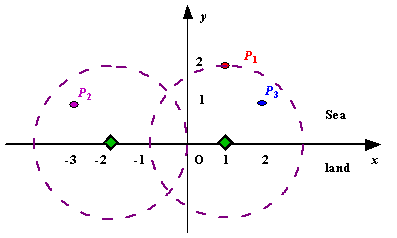Radar Installation
| Time Limit: 1000MS | Memory Limit: 10000K | |
| Total Submissions: 42925 | Accepted: 9485 |
Description
Assume the coasting is an infinite straight line. Land is in one side of coasting, sea in the other. Each small island is a point locating in the sea side. And any radar installation, locating on the coasting, can only cover d distance, so an island in the sea can be covered by a radius installation, if the distance between them is at most d.
We use Cartesian coordinate system, defining the coasting is the x-axis. The sea side is above x-axis, and the land side below. Given the position of each island in the sea, and given the distance of the coverage of the radar installation, your task is to write a program to find the minimal number of radar installations to cover all the islands. Note that the position of an island is represented by its x-y coordinates.

Figure A Sample Input of Radar Installations
We use Cartesian coordinate system, defining the coasting is the x-axis. The sea side is above x-axis, and the land side below. Given the position of each island in the sea, and given the distance of the coverage of the radar installation, your task is to write a program to find the minimal number of radar installations to cover all the islands. Note that the position of an island is represented by its x-y coordinates.

Figure A Sample Input of Radar Installations
Input
The input consists of several test cases. The first line of each case contains two integers n (1<=n<=1000) and d, where n is the number of islands in the sea and d is the distance of coverage of the radar installation. This is followed by n lines each containing two integers representing the coordinate of the position of each island. Then a blank line follows to separate the cases.
The input is terminated by a line containing pair of zeros
The input is terminated by a line containing pair of zeros
Output
For each test case output one line consisting of the test case number followed by the minimal number of radar installations needed. "-1" installation means no solution for that case.
Sample Input
3 2 1 2 -3 1 2 1 1 2 0 2 0 0
Sample Output
Case 1: 2 Case 2: 1
Source
题目链接:http://poj.org/problem?id=1328
题意:有一条直的海岸线,上面有雷达。以海岸线为x轴,x轴上面为海,下面为岸。海里面有很多岛屿。已知雷达的观测半径。问最少建多少个雷达能把所有岛屿都覆盖到雷达
的侦测范围内。如果不能覆盖全部的岛屿,按样例输出Case数和-1,反之输出Case数和最少需要建立的雷达数。
分析:首先算出经过每个雷达且平行于x轴的弦:假设雷达覆盖半径为d。则弦的左端点为x-sqrt (d*d-y*y),右端点为x+sqrt(d*d-y*y)。然后按左端点从小到大排序。由于不能受右
端点的影响,将弦的左右端点横坐标用结构体存起来。然后,将第一个雷达放在排序后的弦投影在x轴的右端点temp。从过第2个岛屿的弦的投影开始扫描,如果右端点
<temp即右端点在雷达左边。把雷达移动到此右端点,此时就能使雷达既覆盖到这个岛屿,又覆盖到前面的岛屿。如果左端点在雷达右边,则不能覆盖,需要再建立一个
雷达。然后把新雷达建在此时弦右端点投影到x轴的坐标。忽略前面的,对后面的岛屿进行同样的操作。(贪心思想)
注意:半径和坐标都有可能是小数,所以用double类型比较好,不然用int又要注意计算时*1.000变为浮点数。
代码:
#include<cstdio>
#include<iostream>
#include<cstring>
#include<algorithm>
#include<cmath>
using namespace std;
struct point
{
double left;
double right;
}p[5012];
bool flag;
int cnt;
bool cmp(point &x,point &y)
{
return x.left<y.left;
}
int main()
{
int cases=0,i,n;
double d;
while(scanf("%d%lf",&n,&d)&&n&&d)
{
flag=true;
double a,b;
for(i=0;i<n;i++)
{
scanf("%lf%lf",&a,&b);
if(fabs(b)>d)
flag=false;
p[i].left=a-sqrt(d*d-b*b);
p[i].right=a+sqrt(d*d-b*b);
}
printf("Case %d: ",++cases);
if(!flag)
puts("-1");
else
{
sort(p,p+n,cmp);
double temp=p[0].right;
cnt=1;
for(i=1;i<n;i++)
{
if(p[i].right<temp)
temp=p[i].right;
else if(p[i].left>temp)
{
cnt++;
temp=p[i].right;
}
}
printf("%d
",cnt);
}
}
return 0;
}
//AC
|
11920732 |
Accepted |
188K |
32MS |
981B |
2013-08-05 00:20:15 |